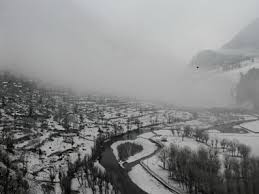History and story of Jammu State
.jpg)
History and story of Jammu State
"As of now said the old name of the State was Durgara, as found on two Chamba copper plate deeds, and of this name the terms Durgar and Dogra, in like manner use right now, are inferences. Till the disclosure of the copper plates a few different deductions were alloted for the starting point of the name. One of these was Dugarta or Dvigarta, that is, "the tract between two streams," viz., the Ravi and Chinab - in similarity with Trigarta or Kangra. By some the name should allude to the two holy pools of Saroin Sar and Man Sar, and the nation around them. These inferences of the name should now be respected absolutely whimsical. The name Durgara is most likely an inborn assignment, as Gurgara, the first of the cutting edge "Gujar". The names Durgar and Dogra are currently connected to the entire zone in the external slopes between the Ravi and Chinab, however this utilization of the terms is presumably of late beginning, and date just from the time when the tract went under the matchless quality of Jammu.
The sequence of Jammu is a clear down to the early piece of the tenth century, when it is alluded to under the name of Durgara. This reference sets up the way that the State at that point existed and was managed by its own boss, called the " master of Durgara." At an impressively later date the references in the Rajatarangini to two Rajas of Babbapura, if acknowledged as applying to Jammu, empower us to settle roughly the consequent rules. We may expect that Vajradhara, who was in control in A.D. 1114-18, prevailing about A.D. 1110, and the most punctual bona fide date after this is of Raja Parasram Dev (A.D. 1589). Between these dates twenty Rajas administered the State, giving a normal rule of around a quarter century. There may have been exclusions of names in duplicating the Vansavali which would decrease this normal, without a doubt one such name is found in the Akbarnamah. Once more, from A.D. 1589 to A.D. 1812 there were twelve rules, giving a normal of about twenty years. These midpoints are with regards to those of numerous other slope States.
As in different parts of the slopes, Jammu State was most likely gone before by a long stretch of government by negligible boss, called Ranas and Thakurs. The conventions identifying with this Thakurain period, as it is called, are less distinct toward the west than toward the east of the Ravi, yet in the chronicled records of the greater part of the States in the Jammu region there are genuinely certain confirmations of such a political condition. These conventions, nonetheless, are slightest distinct in the most seasoned States, having presumably gone into insensibility through slip by of time. The establishment of a portion of the States is unmistakably connected with the victory of at least one of these negligible noblemen. There are no references to the Ranas in the Jammu Vansavali, and it is uncommon to discover such references on account of exceptionally old States, yet in the old stories of the general population customs of the antiquated nation are common.We may along these lines accept that for a long time after Jammu State was established the peripheral segments, which at a later period wound up plainly discrete and free States, were under the manage of Ranas and Thakurs, conceivably with a free devotion to Durgara.
The Dogra imperial line follow their drop from Kus, the second child of Rama, and came initially, it is stated, from Ayodhya. Like Chamba and numerous other illustrious groups of the slopes, they have a place with the Surajbansi race and the tribe name is Jamwal. Presumably there was a more established assignment which has been overlooked.
The Manhas Rajputs, an expansive rural clan found along the foot of the external slopes between the Ravi and the Jehlam, claim to be slid from an indistinguishable progenitor from the Jammu regal group. The convention among them is that from an early period a portion of the more youthful individuals from the illustrious faction took to horticulture, and as following the furrow is against Rajput feeling, they in this way ended up noticeably corrupted, and are looked downward on by the individuals who hold fast to antiquated custom. The greater part of the Manhas, it is stated, can follow their drop from head of the different States under various branches of the 'Jamwal illustrious family. It is impossible that Jamwal was the first name of the clan as recommended by Ibbetson. The name can date just from the time when Jammu turned into the capital and it is connected just to the regal family and its branches.
The early history of the State is lost in the fogs of the past and even normal convention is quiet. The main Raja, named Agnibaran, is said to have been a sibling or brother of the Raja of Ayudhya. He came up into the Punjab by method for Nagarkot (Kangra), and subsequent to intersection the Ravi settled at Parol close Kathua, inverse to Madhopur in the Gurdaspur Region. As indicated by the records this, if valid, probably been at an early period. His child, Vayusrava, added to his region the nation of the external slopes as far west as the Jammu Tawi. Four different Rajas followed in progression and the fifth was Agnigarbh, who had eighteen children, of whom the two most seasoned were Bahu-lochan and Jambu-lochan. Bahu-lochan succeeded his dad and established the town and stronghold of Bahu, on the left bank of the Tawi, inverse Jammu, and made it his capital. In looking to broaden his regions towards the fields he fell in fight with Chandarhas, at that point Raja of the Punjab (Madhyadesa) whose capital was likely at Sialkot. The reference is fascinating and likely chronicled. The war with Chandarhas certainly was the result of an endeavor with respect to the slope boss to augment the State limits towards the fields. Custom avows that in previous circumstances the region stretched out significantly more distant toward the south than now, and the Raja of Sialkot would normally contradict such infringements on his outskirts.
Sialkot has been related to the antiquated Sakala, the Sagala of Buddhist writing, which is in this manner turned out to be one of the most established urban communities in the Punjab. In extremely antiquated circumstances it was the capital of the Madras who are known in the later Vedic period, and Sakaladvipa or " the island of Sakala " was the old name of the doab between the streams Chandrabhaga (Chenab) and Iravati (Ravi). In to some degree later circumstances (c. B.C. 200) Sakala was the capital of the later Graeco-Indian rulers of the place of Euthymedus, who managed the Eastern Punjab, and it was the living arrangement of Alenander who has been related to lord Melinda, who is known from the Buddist treatise called "The Inquiries of Melinda." His date was about B.C. 150. At a still later period Sakala was the capital of Salavahana, whose child, Rasalu, is the considerable saint of all Punjab convention, and after the attack of the Hunas (Huns) in the last piece of the fifth century A.D. it turned into the capital of Toramana and his child Mihirakula, who controlled over the Punjab and furthermore likely finished Kashmir. As Jammu is just thirty miles from Sialkot, and the limit even right now is inside seven miles of the last place, it is clear that successive question probably emerged in previous circumstances, like that alluded to in the Vansavali.
Jambu-lochan took after and proceeded with the war with Chandar-has in which the last was killed. He is then said to have established the town of Jammu. The story is along these lines related: Jambu-lochan on getting to be Raja wished to establish another town as ^ his capital and name it after himself. With this in see he went out chasing one day joined by his
authorities, and intersection the Tawi he found in the wilderness a deer and a tiger drinking at a similar tank. Being astounded at the sight he came back to his tent and calling his Clergymen enquired the importance of such an abnormal event. They answered that the clarification lay in the way that the dirt of the place exceeded expectations in temperance and thus no living animal bore animosity against another. The Raja along these lines reached the conclusion this was only the sort of site he was looking for and established another town, calling it Jambupura.'
The spot on which the tank was found is currently called Purani Mandl,'- a territory in Jammu town, where the Rajas on their increase get the rajtilak, or characteristic of instatement at the season of establishment. The Purani Mandi marks the spot where the royal residence initially stood, and the Rajas dwelled for quite a long time. It is close to the little sanctuary of Raghunath (Rama) called " Maharani ka Mandir," established by the Bandhrali Rani of Maharaja Ranbir Singh. An awesome number of individuals are every day bolstered there, and get every one pice in trade out name of the rani. The present Purani Mandi structures are said to have been raised by Raja Mal Dev, likely in the fourteenth century. The present royal residence is current and was raised by Maharaja Gulab Singh.
Jammu has no old structures or remains, nor anything to show that it is a position of incredible relic. The sanctuaries, which are for the most part a beyond any doubt confirmation of age, are for the most part current. The place has a huge populace, however its thriving is of late date. The most punctual verifiable say of Jammu is regarding Timur's attack in A.D. 1398-
- In the Tarikh-I-Kashmlr-I-Azami (A.D. 1417) a Raja of Jammu is alluded to and the town is talked about as then around five hundred years of age. We may hence infer that it was established about A.D. 900. It is very conceivable, notwithstanding, that Jammu may date from a prior period, as the legend says; however it might not have been a position of any significance and did not turn into the capital till a later time."
If u like my post so please upvote 4 upvote
Resteemed by @resteembot! Good Luck!
The resteem was payed by @greetbot
Curious?
The @resteembot's introduction post
Get more from @resteembot with the #resteembotsentme initiative
Check out the great posts I already resteemed.
Hmm
Nice post
Thanks
e nice
Thanks
☺
Hi. I am @greetbot - a bot that uses AI to look for newbies who write good content.

I found your post and decided to help you get noticed.
I will pay a resteeming service to resteem your post,
and I'll give you my stamp of automatic approval!
Hmm